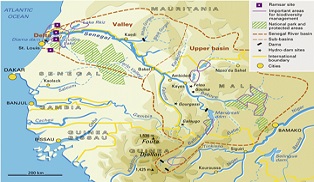Senegal River Basin Development Organization (OMVS)
| Venue : Republic of Senegal | |
|
Over the years, with an increasing climate deregulation, resulting in fewer rainfalls leading to severe drought, the need for water grew substantially in the region and was brought to the political agenda of the riparian States of the Senegal River. In March 1972, these efforts led to the creation of the Senegal River Basin Development Organization (OMVS), the “only African river management entity that has systematically implemented the principle of equitable sharing among Member States when it comes to ownership of infrastructure constructed in the river basin or water resource benefits” (Komara, C). The missions of the organisation are the following: achieving sustainable food self-sufficiency for the populations of the basin and the sub-region, ensuring security of people and increase their income, maintaining the balance of ecosystems across the basin, reducing vulnerability of the Member States’ economies to climate related hazards and external factors, and speed up the economic development of the Member States. Since its establishment in 1972, the Organisation implemented successfully several projects, including:
For more information, please visit: http://www.omvs.org/ For more information, please visit: https://blogs.worldbank.org/nasikiliza/setting-example-cooperative-management-transboundary-water-resources-west-africa |
|
 The Senegal River is the third longest river in Africa with 1,800 kilometers. Its source is located in the Fouta Djallon Highlands in the Republic of Guinea and runs through the Republic of Mali, Senegal, and Mauritania where it meets the Atlantic Ocean. Livelihoods of thousands of people depend on it as it is mainly used for the purposes of irrigation, ensuring drinkable water, and energy production.
The Senegal River is the third longest river in Africa with 1,800 kilometers. Its source is located in the Fouta Djallon Highlands in the Republic of Guinea and runs through the Republic of Mali, Senegal, and Mauritania where it meets the Atlantic Ocean. Livelihoods of thousands of people depend on it as it is mainly used for the purposes of irrigation, ensuring drinkable water, and energy production.